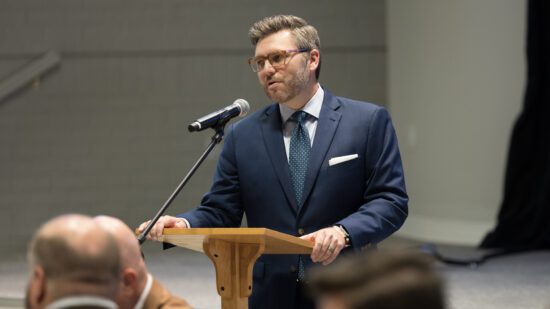It was 2001, and our friends and family probably thought we were crazy. We were newlyweds, only 16 months into our marriage, and we bought a house—with my parents. We installed a kitchen downstairs and were fully autonomous, but I still cringed with worry that people would think we couldn’t grow up and live like adults.
It was a synergistic move because we were able to combine incomes and buy a home in a more expensive area that was closer to church and work. Yes, we were doing something highly unusual in our area; we were choosing to live in a multigenerational community with my parents.
We had our share of discussions about social and emotional boundaries, and thanks to my husband’s ninja spreadsheet skills, we had the financial guidelines in place. But it wasn’t until our first child was born five years later that we realized how much we needed this kind of community. Entering motherhood was a messy, gnarly experience for me. My parents were right there, available if we needed them, yet not butting in while we figured things out. They delighted in our son as only grandparents can. The spontaneous date nights were amazing. We felt like geniuses of the first order!
The richness of a multigenerational community
We live in a culture that has largely lost its sense of a multigenerational community. The old sit secluded in their nursing homes while young moms sit isolated at home with their babies. Despite the flare of social media, our brains are not getting the interaction they need for real joy and fellowship. Our churches even have divided services to serve preferences for music and styling. However, a total lack of integration between the generations does, indeed, cost us something.
Here are several things this rich experience taught us about a multigenerational community:
- It strengthens our sense of identity. It reminds us of who we are and where we came from. In many cultures, being an elder is a position of great esteem. They hold the stories from generations before and have the skills to teach the younger. In his collaborative book, Joy Starts Here, Jim Wilder states it this way, “Children have the most energy; adults have the most power; and the elderly have the most time.” We need all three to build our communities, churches, and fellowships.
- It strengthens the brains of our children. We experienced this acutely in our son with autism. Scientific research is shedding light on the importance of bonding in the first years of life. Research shows that a child’s brain “lights up” when someone is glad to be with them. Joy grows the brain! This “joy strength” sets a baseline for life and enables a person to do hard things, regulate their emotions, and move forward in maturity. For more information on this topic, see Wilder’s book Joy Starts Here.
- It strengthens our marriages. One doctor I spoke with said that the modern mother isn’t prepared emotionally or socially for motherhood. What important job doesn’t require an internship or training? Yet without multigenerational interaction, how will a young couple learn how to communicate, or a mother and father ever be prepared for the daunting task of parenthood?
- It provides greater context for the stages of life. Our sons lived out their daily lives while their grandfather (who was also their pastor) died of cancer in their basement. Though it was difficult to expose them to hospice and death, it was an essential part of their grandfather’s testimony. They watched him suffer well and trust the Lord through every step. This experience gave them greater resiliency, depth, and faith.
How you can implement a multigenerational community
So, how can you begin to implement a multigenerational community in your church and family? Her are a few suggestions:
- No matter your age, delight in the youth of your church or family. They need you! Give teens important things to do. Adolescence, as a group, only began around the Industrial Revolution, when there was a season of life after childhood but before adulthood. It’s important that we give them opportunities to channel their energy and passions for the Lord.
- Don’t google every question in life. We deprive the elderly of a purpose each time we ask Siri. Asking an elder provides the context for relational interaction. Also, take your kids to visit the elderly, and allow them to build joy together. Mine the treasure of their life experiences.
- Invite those from your church who are in a different age group over for a simple dinner. Enjoy each other’s company. If they are believers, you already have the greatest and most important thing in common. This interaction between generations benefits everyone. If you are a parent of young children, it will model to them that you value the elderly, and that will pay off when you are the grandparent. If you are an elder, it gives younger generations the opportunity to learn and grow from your experiences.
Seventeen years into our living situation, I can see God’s kindness and provision. I wouldn’t have chosen for my son to struggle with autism or for my dad to suffer and die at the age of 69, but because of God’s sovereign plan, the widow has a home with laughter and purpose. The overwhelmed mother has support. The worn out parents have the space to breathe and remember why they love each other. And the children have growing brains and spirits, knowing they are delighted in by multiple generations.
In John 17, Jesus prays for believers. His prayer is that they may be one so that the world will know that God sent him. Our unity as believers has a major effect on how people see Jesus. Our chesed (loosely translated from hebrew as “sticky love”) matters. We live in unprecedented times where the chasm between generations can seem insurmountable. May Christ be our all so that the greatest connections we experience are with those who also share his mind and heart, not necessarily our age bracket.









